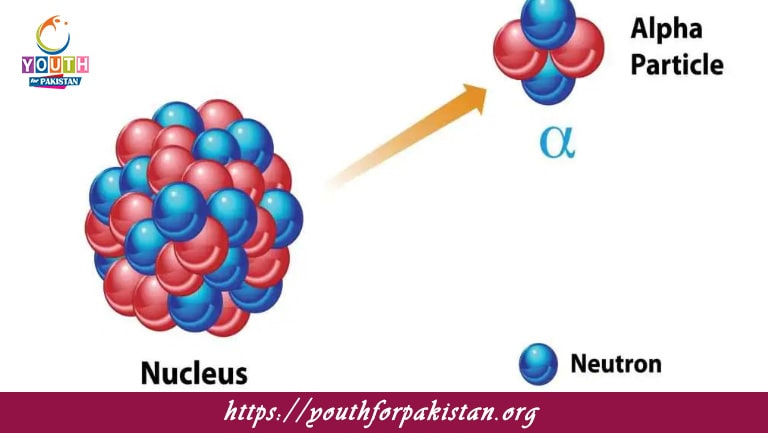Spontaneous And Random Nuclear Decay MDCAT MCQs

Welcome to the Spontaneous And Random Nuclear Decay MDCAT MCQs with Answers. In this post, we have shared Spontaneous And Random Nuclear Decay Multiple Choice Questions and Answers for PMC MDCAT 2024. Each question in MDCAT Physics offers a chance to enhance your knowledge regarding Spontaneous And Random Nuclear Decay MCQs in this MDCAT Online Test.
What is emitted during alpha decay?
A) Two protons and two neutrons
B) Two electrons and two protons
C) Two neutrons and two positrons
D) One proton and one neutron
Which of the following particles is emitted during beta minus decay?
A) Positron
B) Neutron
C) Electron
D) Proton
During gamma decay, which of the following is emitted?
A) An electron
B) A photon
C) A neutron
D) A proton
What happens to the atomic number of an element during beta plus decay?
A) Increases by 1
B) Decreases by 1
C) Increases by 2
D) Remains the same
The process in which a neutron decays into a proton, electron, and antineutrino is called:
A) Alpha decay
B) Beta minus decay
C) Gamma decay
D) Positron emission
The time taken for half the nuclei in a sample to decay is called:
A) Half-life
B) Decay constant
C) Activity
D) Mean life
Which of the following statements is true about spontaneous nuclear decay?
A) It requires an external trigger.
B) It is a random process.
C) It only occurs in stable nuclei.
D) It always results in gamma emission.
In positron emission, a proton is converted into a:
A) Neutron and an electron
B) Neutron and a positron
C) Neutron and a neutrino
D) Neutron and an antineutrino
The decay constant is:
A) The probability of decay per unit time
B) The time taken for all nuclei to decay
C) The number of decays per second
D) The amount of energy released during decay
What type of radiation is emitted when an unstable nucleus releases excess energy without changing its composition?
A) Alpha radiation
B) Beta radiation
C) Gamma radiation
D) Neutron radiation
In beta plus decay, what particle is emitted along with a positron?
A) Electron neutrino
B) Electron antineutrino
C) Neutron
D) Photon
The process of a nucleus capturing one of its own orbital electrons is known as:
A) Electron capture
B) Alpha decay
C) Beta decay
D) Positron emission
In spontaneous fission, a nucleus:
A) Absorbs a neutron and splits
B) Splits into smaller nuclei without neutron absorption
C) Emits a gamma ray
D) Releases a positron
What is the main difference between alpha and beta decay?
A) Alpha decay emits a helium nucleus, beta decay emits an electron
B) Alpha decay emits an electron, beta decay emits a positron
C) Alpha decay increases atomic number, beta decay decreases it
D) Alpha decay is slower than beta decay
What type of decay decreases the mass number by 4?
A) Beta decay
B) Alpha decay
C) Gamma decay
D) Neutron decay
The emission of radiation by unstable nuclei is known as:
A) Radiation therapy
B) Radioactive decay
C) Nuclear fusion
D) Nuclear fission
Which type of decay involves the emission of an antineutrino?
A) Alpha decay
B) Beta minus decay
C) Gamma decay
D) Beta plus decay
In nuclear decay, what does the term “spontaneous” mean?
A) The decay occurs due to external stimuli
B) The decay occurs without external stimuli
C) The decay can be predicted accurately
D) The decay does not produce radiation
The random nature of nuclear decay means:
A) The rate of decay can be controlled
B) The decay occurs at regular intervals
C) It is impossible to predict which nucleus will decay next
D) The decay always releases the same amount of energy
The half-life of a radioactive isotope is the time it takes for:
A) All of the isotope to decay
B) Half of the isotope to decay
C) The isotope to lose its radioactivity
D) The isotope to emit gamma rays
What happens to the atomic mass of a nucleus during alpha decay?
A) Decreases by 4 units
B) Increases by 4 units
C) Decreases by 2 units
D) Increases by 2 units
What type of decay can result in the formation of a different element?
A) Alpha decay
B) Gamma decay
C) Electron capture
D) Both A and C
Which type of radiation has the highest penetrating power?
A) Alpha particles
B) Beta particles
C) Gamma rays
D) Neutrons
What is the nature of the radiation emitted in gamma decay?
A) Particulate
B) Electromagnetic
C) Positronic
D) Neutrino
Which particle is emitted in beta minus decay?
A) Positron
B) Electron
C) Neutron
D) Proton
What happens to the neutron-to-proton ratio in a nucleus after beta minus decay?
A) Increases
B) Decreases
C) Remains the same
D) Becomes zero
The process of positron emission involves:
A) A neutron decaying into a proton
B) A proton decaying into a neutron
C) An electron decaying into a positron
D) A gamma photon decaying into an electron and positron
In electron capture, an electron is absorbed by:
A) The nucleus
B) A neutron
C) A proton
D) A positron
What is a common application of gamma rays?
A) Sterilization of medical equipment
B) Communication signals
C) Power generation
D) Cooking food
The rate at which radioactive decay occurs is measured in:
A) Joules
B) Becquerels
C) Newtons
D) Volts
What type of decay involves the release of two protons and two neutrons?
A) Beta decay
B) Alpha decay
C) Gamma decay
D) Electron capture
During beta minus decay, what happens to a neutron in the nucleus?
A) It becomes a proton
B) It becomes a positron
C) It is emitted as radiation
D) It remains unchanged
What is a characteristic of all types of radioactive decay?
A) They emit alpha particles
B) They involve the release of energy
C) They occur at a constant rate for each element
D) They increase the mass number of the element
Which of the following is true about the half-life of a radioactive substance?
A) It depends on the initial amount of the substance
B) It can be affected by environmental conditions
C) It remains constant for a given isotope
D) It can be increased by heating the substance
Which of the following is NOT a product of spontaneous nuclear decay?
A) Neutrino
B) Neutron
C) Photon
D) Neutron star
What type of radiation is emitted when an excited nucleus returns to its ground state?
A) Alpha radiation
B) Beta radiation
C) Gamma radiation
D) Neutron radiation
The term “radioisotope” refers to:
A) Any stable isotope
B) An isotope that emits radiation
C) An isotope that does not undergo decay
D) A synthetic isotope
Which decay process increases the atomic number by one?
A) Alpha decay
B) Beta minus decay
C) Beta plus decay
D) Electron capture
In nuclear physics, what is a “decay chain?
A) A series of reactions that split an atom
B) A sequence of decays that lead to a stable isotope
C) A reaction that fuses multiple nuclei
D) A process that captures neutrons
The stability of a nucleus is determined by:
A) The total mass of the atom
B) The balance between nuclear forces and electromagnetic repulsion
C) The number of protons alone
D) The number of electrons in orbit
If you are interested to enhance your knowledge regarding Physics, Chemistry, Computer, and Biology please click on the link of each category, you will be redirected to dedicated website for each category.





